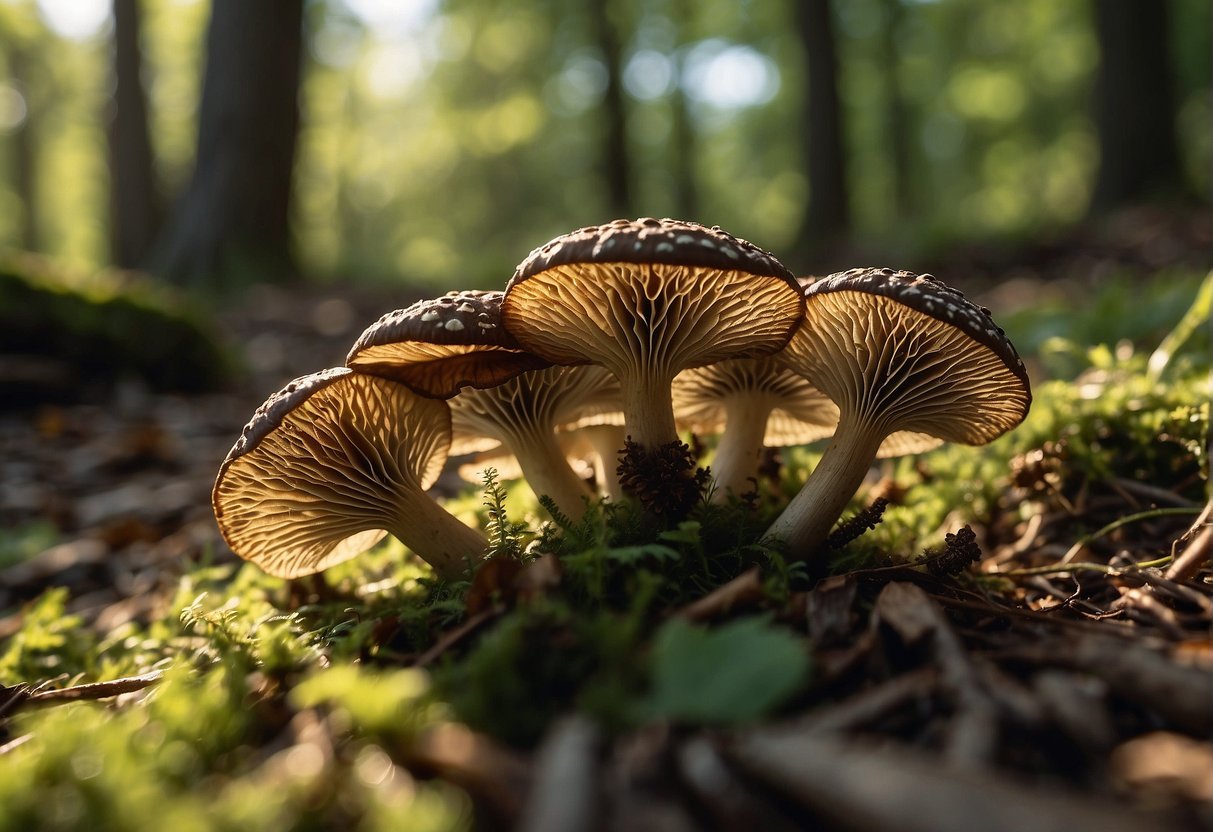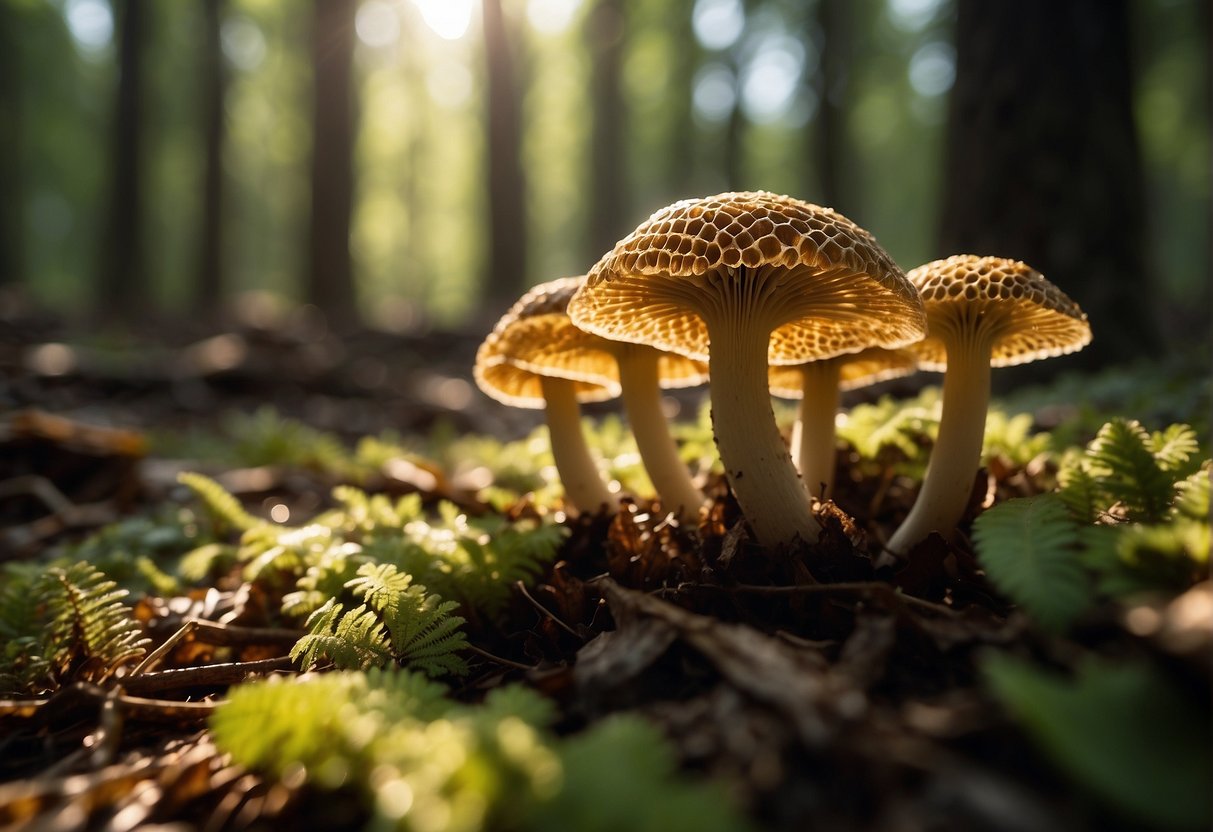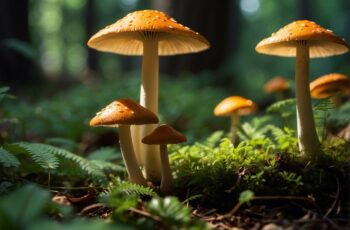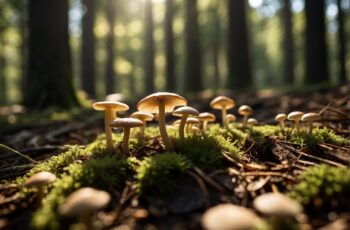As spring unfolds across the rolling forests and lush valleys of Ohio, it heralds the perfect time for local foragers and nature enthusiasts to seek out the elusive morel mushroom. Morels are prized by chefs and gourmets alike for their unique, earthy flavor and are among the most sought-after wild mushrooms in the state. If you’re keen on joining the foraging community or are just an admirer wanting to know more, understanding the basics of morel mushroom hunting in Ohio is essential.

The art of finding morel mushrooms in Ohio combines patience, keen observation, and a good knowledge of their preferred growing conditions. These distinctive fungi favor areas with moist soil and are commonly found in and around the deciduous woodlands endemic to the region. Looking for morels can be a rewarding pastime, allowing you to enjoy Ohio’s natural beauty while possibly adding a delicious ingredient to your next meal.
Key Takeaways
- Morel mushrooms are a seasonal delicacy in Ohio and should be harvested responsibly.
- Accurate identification of morels is crucial for a safe and enjoyable foraging experience.
- Knowledge of ideal habitats can greatly increase your success in finding morel mushrooms.
Identifying Morel Mushrooms in Ohio
As an enthusiast of the outdoors and mushroom foraging, you’ll find that Ohio presents a rich array of morel mushrooms. But it’s essential to distinguish the true morels from false ones for a safe and rewarding experience.
True Morels vs False Morels
True morels (Morchella spp.) have a distinctive honeycomb appearance with pits and ridges, while false morels (Gyromitra spp. and others) have wavy or lobed caps. True morels are hollow from stem to tip when split open; false morels contain cottony or chunky fillings. For your safety, always closely examine and confirm your find before consumption. False morels contain harmful compounds and should never be eaten.
Varieties Found in Ohio
You’re likely to encounter three main varieties of morels in Ohio:
- Black Morels (Morchella elata): These tend to appear first in the season and are smaller with a darker color.
- Gray Morels (Morchella tomentosa): These can be found maturing into a yellowish color as they grow.
- Yellow Morels (Morchella esculenta): These are the largest and most sought after due to their size and flavor.
Keep a sharp eye out as each variety has its favored conditions and habitats.
Optimal Conditions for Morel Growth
Morels are elusive, but certain conditions can increase your chances of success. They thrive in moist soil with temperatures ranging from 60 to 70 degrees Fahrenheit. You’ll often find these fungi in wooded areas, particularly amidst ash, elm, and apple trees, following a good rain. Remember, consistency in day-to-day temperatures plays a crucial role in the emergence of morel mushrooms in Ohio. As you set forth on your quest, be mindful of these optimal growth conditions to improve your likelihood of a bountiful harvest.
Best Locations for Hunting Morel Mushrooms
When you’re gearing up for morel mushroom hunting in Ohio, knowing where to start is key. Focus on areas with a mix of ash and elm trees, and look for the specific environments where morels thrive.
State Parks and Public Lands
Ohio’s state parks and public lands are prime territory for your next foraging venture. Wooded areas with a blend of ash trees and elm trees, particularly in places recovering from floods or fires, are especially fertile grounds. Brush Creek, in the foothills of the Appalachians, is noted for its rich soil conducive to morels. Meanwhile, state parks offer a range of habitats where these elusive fungi love to hide.
- Hocking Hills State Park: A haven with deep forests and moist conditions.
- Shawnee State Forest: Known as ‘the Little Smokies,’ its diverse ecosystem supports morel growth.
Remember, always check the latest guidelines for foraging, as parks might have specific rules.
Private Property and Foraging Laws
If you’re eyeing private property, be sure you have permission. Morels may be plentiful on private lands, but respect for property rights is a must. Foraging laws in Ohio are clear – it’s illegal to trespass for any reason, including mushroom hunting. Establish a good relationship with landowners, and they might just share their secret spots.
- Get written permission: This not only covers legalities but also builds trust.
- Be mindful of the landscape: Your footsteps today should not disrupt the possibility of morels tomorrow.
Focus on finding those hidden gems, respect the land, and happy hunting!
Foraging Tips and Techniques

Embarking on the journey of foraging for morel mushrooms in Ohio can be both rewarding and challenging. Mastering a few key strategies and understanding the importance of safety and ethics will significantly enhance your foraging experience.
Strategies for New Foragers
For novice morel mushroom hunters, the importance of timing cannot be overstressed. You will find that morels often emerge when soil temperatures reach about 53 degrees Fahrenheit after a period of rain. Be sure to dress appropriately for the outdoors and venture into areas where morels are known to grow, such as woodlands or near elm, ash, and aspen trees.
Start your hunting efforts by scanning the base of trees and brush, as morels often populate these areas. It’s advisable to carry a mesh bag to collect your finds, which allows the spores to disperse and promote future growth as you continue your hunt. An early morning start can also give you an edge, as you’ll be able to take your time and thoroughly scan the landscape before others arrive.
Safety and Ethical Considerations
Safety is paramount when mushroom hunting; ensure that you have a clear understanding of what a morel looks like, as there are poisonous mushrooms that can be mistaken for morels. Carry a field guide or use reputable resources like the Ohio Mushroom Society, which can aid in proper identification.
When practicing off-trail collecting, it’s crucial not only for your safety but also for the preservation of the ecosystem to stick to paths as much as possible to avoid trampling over undiscovered growth. Always seek permission if you’re foraging on private land, and be mindful of local regulations if you’re in state forests or wildlife management areas.
Additionally, being ethical in your forage means taking only what you need and leaving enough mushrooms to ensure continued growth for the next season. It’s a practice and a privilege to be part of the foraging community, so always consider the environmental impact of your actions.
Using and Preserving Ohio Morels
The allure of morels lies not just in the hunt but in their earthy flavor and versatility in the kitchen. Once you’ve foraged your bounty, the next steps are critical to ensure your morels are deliciously safe to consume and can be enjoyed even after the season ends.
Cooking and Preparation
You’ve done the hard work of hunting down those elusive Ohio morels, and now it’s time to cook them. Always remember to clean your morels thoroughly to remove any dirt and possible critters. This can be done by gently rinsing them under cold water and patting them dry. For cooking, morels are best enjoyed when kept simple to let their unique flavor shine. Sautéing in butter with a pinch of salt is a classic method. Alternatively, pan fry them with a light breading to add a satisfying crunch. Here’s a straightforward approach to get you started:
- Heat a pan over medium heat.
- Melt a tablespoon of butter.
- Add the morels, sprinkle with salt, and cook until they are golden brown and tender.
Preservation Methods
When you’ve got more than you can eat, preserving your morels allows you to maintain that woods-fresh flavor. Dehydration is a favored method among foragers as it keeps the mushrooms’ integrity and taste intact. Simply slice your morels in half, arrange them on a dehydrator tray, and follow the manufacturer’s instructions, usually drying at around 110-115°F until crispy. In the absence of a dehydrator, you can use an oven on a low setting with the door slightly open. Morels can also be preserved by freezing. Cook them in butter first, then cool and store in airtight containers before placing them in the freezer. This method locks in the flavor and makes them easy to use in future meals.


